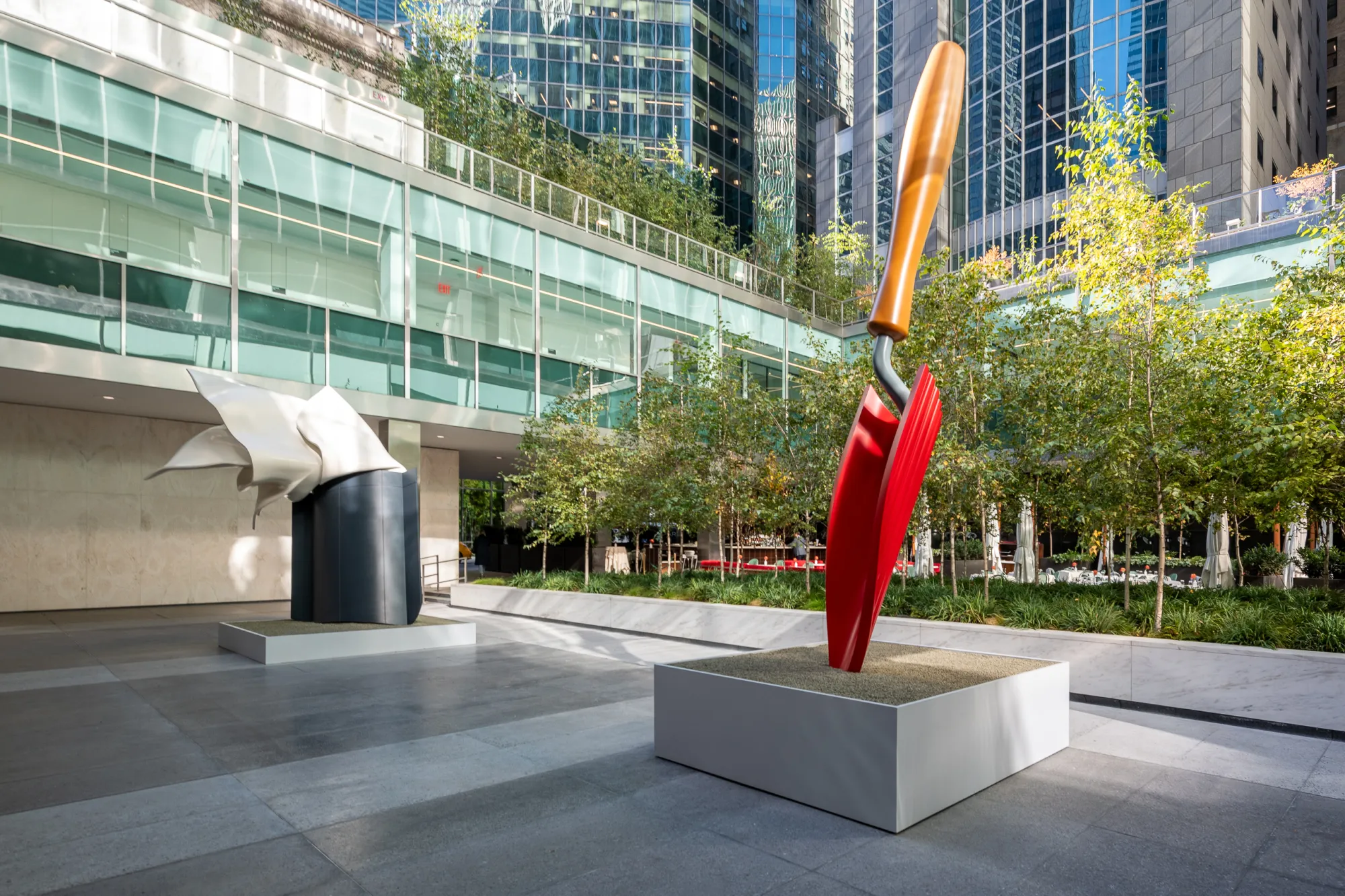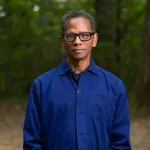
Editor’s Note: This story is part of Newsmakers, a new ARTnews series where we interview the movers and shakers who are making change in the art world.
On Monday, Jacob King, the founder of art advisory firm Fine Art Concepts and curator of the art program at Manhattan’s Lever House, opened his latest exhibition celebrating the work of Claes Oldenburg and Coosje van Bruggen.
The first major presentation of the duo’s work since Oldenburg’s passing in 2022, the exhibition transforms the landmark Lever House into a dynamic showcase for their monumental sculptures, early plaster works, and iconic “soft” sculptures. Two large-scale outdoor sculptures installed in the building’s central courtyard—Plantoir and Architect’s Handkerchief—steal the show, offering a cheeky dialogue between public art and architectural history.
Plantoir (2001-2021) is a 16-foot tall garden trowel that’s both playful and provocative. Its exaggerated scale turns an everyday gardening tool into a monumental statement, reflecting Oldenburg and van Bruggen’s signature approach to elevating humble objects. The placement of Plantoir next to Lever House’s iconic planter—a midcentury innovation blending interior and exterior spaces—heightens its impact.
Architect’s Handkerchief (1999) reaches twelve feet high, its sweeping form seemingly caught mid-motion. Inspired by the pocket squares associated with modernist architect Mies van der Rohe, the work humorously transforms a detail of personal style into an architectural-scale intervention. Positioned to “blow” toward the Seagram Building across Park Avenue—a design also credited to van der Rohe—it embodies the playful yet critical spirit of Oldenburg and van Bruggen’s practice.
Inside the newly restored lobby, visitors will encounter a variety of Oldenburg and van Bruggen’s sculptures from different phases of their careers. Early plaster works, originally shown in 1961, bring to life the artist’s beginnings in the East Village, when he used lowly materials to depict consumer goods and mundane objects. These early pieces, alongside the soft sculptures of the 1960s and 1970s, reflect the booming consumer culture of postwar America and challenge viewers to reconsider the objects that shape everyday life. The lobby’s vitrines—once used to display Lever Brothers’ soap and household products—now house these works, creating a dialogue between past and present, art and commerce.
ARTnews sat down with King to talk about sourcing sculptures for the exhibition and how shows come together at Lever House.
This interview has been edited lightly for concision and clarity.
Tell me about how this project started, and why the Lever House?
The Lever House was once owned by the collector Aby Rosen for something like 20 years before it was bought by Brookfield Properties and WatermanCLARK. Rosen did shows in the lobby and the plaza that, especially in the later years, were very commercially driven. Rosen would often work with a younger artist, who produced a lot of work for the show that Rosen would eventually buy at a discount. This eventually became the Lever House art collection. And some of those shows were really great: Peter Halley, Sarah Morris, and Jeff Koons. But it was very limited in terms of what you could do. The building was treated like a Kunsthalle—they would build walls and show lots of work, and it would all change every six or eight weeks. So, after Brookfield and WatermanCLARK took over and restored the building, we had a lot of conversations about how we could continue the art program—which has become really integral to the character of the building—while differentiating it from the past. Brookfield has a really deep commitment to putting important artworks in public buildings. I’ve done a number of projects with them now. It’s so rare, but they really understand what great art is, and they have the commitment and the capacity for certain amount of risk that you have to take to realize a public art project like this.
Is that one person within Brookfield, or is it a company culture?
Bruce Flatt is the CEO. His wife is Lonti Ebers, who is an incredible collector on the board of the [Museum of Modern Art]. Some of that culture probably filters through Bruce and Lonti. Take the restoration of Lever House, for example. Brookfield spent $100 million pouring over the Skidmore, Owings & Merrill archives and trying to restore every detail. Lever House is essentially a brand new building, from 1952, with modern fittings. One of the things that we arrived at relatively quickly was the space for sculpture. It’s one of the first glass buildings. To hang paintings here you have to put up temporary walls which would interfere with the whole space. We also decided that, instead of commercially-driven short-term shows, we would do one museum-quality exhibition a year. That’s very challenging because installing large sculpture requires screwing things in. It requires all kinds of supports and structural weight, and every surface in this building is historically protected. We can’t drill into anything. There is a lot of logistics involved. Our first show was sculptures by Ellsworth Kelly, in collaboration with Matthew Marks, in order to coincide with the centennial of Kelly’s birth. It was beautiful, and it really showcased the building. Kelly’s work is so much about positive and negative space. The sculptures really drew attention to all of the materials and the surfaces around them.
When was that that show?
It opened in 2023 and closed this August. It was a real process: learning how to install the works, and predicting how the public would interact with the art. Shortly after [the Kelly show closed], I was meeting with Steve Henry [a senior partner] from Paula Cooper about something totally unrelated, and I saw on his desk all of these printouts of amazing early works about Claes Oldenburg. I asked him about them, and he said that he and Paula were just at Maartje Oldenburg’s, at Claes’s former studio, and she basically said, “Go through what we have here, and feel free to take whatever you want for the gallery.” Steve was considering a show at the gallery. That’s when it occurred to me that Lever House would be an ideal place to do something extraordinary, a big public showing of Oldenburg’s work in New York, the first since he passed away in 2021. I spoke with the team at Brookfield and Waterman Clark, and everyone immediately understood that these are great works and that it would be an amazing context for them.
Was it difficult to source the works for an exhibition like this?
The outdoor works were the most challenging. There’s actually very few large-scale Oldenburg works, and most of them are in sculpture parks or museums or they’re owned by collectors that have them on their lawn. I was surprised how few of them there are and how difficult they are to get.
Where did the two large outdoor sculptures come from?
They are both from the estate. Architect‘s Handkerchief actually was installed publicly in Chicago on Lake Shore Drive for a number of years, until the summer when we pulled it out and put it here. The Plantoir is the last edition of the last large-scale sculpture that Claes and Coosje did. It was actually fabricated just for the show and came right from Germany. I just love that piece. And what’s really interesting is that it harkens back to the first collaboration that Claes and Coosje produced and his first public artwork, a giant 20-foot sculpture he made in 1971, Sculpture in the Form of a Trowel Stuck in the Ground. He made it for Sonsbeek and, in 1975, it was installed at the Kröller-Müller Museum in Otterlo [in the Netherlands]. It’s still there.
Claes Oldenburg & Coosje van Bruggen will be on view at Lever House, 390 Park Avenue, New York, New York until November 30, 2025.


